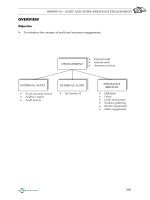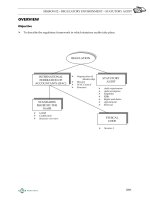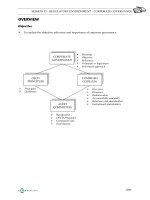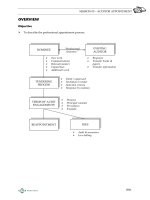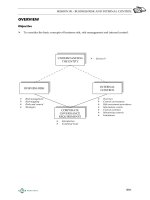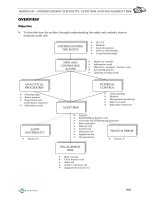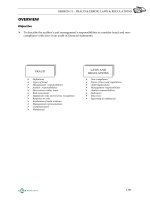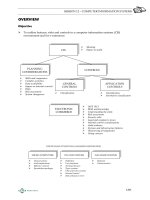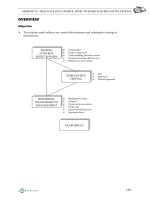F8 aa (int)session32 j08
Bạn đang xem bản rút gọn của tài liệu. Xem và tải ngay bản đầy đủ của tài liệu tại đây (181.7 KB, 8 trang )
SESSION 32 – REVIEW ASSIGNMENTS AND REPORTS
OVERVIEW
Objective
¾
To illustrate the work carried out, matters reported on and opinions provided in review
assignments.
REVIEW
ASSIGNMENT AND
REPORTS
PROCEDURES
¾
¾
¾
¾
Objective
General principles
Terms of engagement
Procedures and evidence
REPORTS
¾
¾
¾
¾
Basic elements
Guidance on wording
Modifications
Financial references
A comprehensive review work program set out in Appendix 4 and must be studied
3201
SESSION 32 – REVIEW ASSIGNMENTS AND REPORTS
1
PROCEDURES
1.1
Objective
To enable an auditor to state whether, on the basis of procedures which do not provide all
the evidence that would be required in an audit, anything has come to the auditor’s
attention that causes the auditor to believe that the financial statements are not prepared, in
all material respects, in accordance with an identified financial reporting framework
(negative form of report, limited assurance).
¾
The standards and guidance provided by ISRE 2400 Engagements to Review Financial
Statements may also be relevant to the review of other financial and non-financial
information.
1.2
General principles
¾
Comply with “Code of Ethics for Professional Accountants”
¾
Review in accordance with ISAs
¾
Exercise professional scepticism
¾
Obtain sufficient appropriate evidence primarily through inquiry and analytical
procedures.
1.3
Terms of engagement
1.3.1
Matters included
¾
Objective of the service being provided (e.g. as above)
¾
Management’s responsibility for financial statements.
¾
Scope of review, including reference to this ISA.
¾
Unrestricted access to whatever records, documentation and other information
requested in connection with the review.
¾
A sample of the report expected to be provided.
¾
Engagement cannot be relied upon to disclose errors, illegal acts or other irregularities
(e.g. fraud) that may exist.
¾
Statement that an audit is not being performed and that an audit opinion will not be
expressed.
3202
SESSION 32 – REVIEW ASSIGNMENTS AND REPORTS
Example 1
Suggest THREE further matters that might be included in an engagement letter
for a review engagement.
Solution
¾
¾
¾
1.4
Procedures and evidence
1.4.1
Matters to consider
¾
Knowledge acquired by carrying out audits or reviews of financial statements for prior
periods.
¾
Auditor’s knowledge of business (including accounting principles/industry practices).
¾
Entity’s accounting and control system.
¾
Extent to which a particular item is affected by management judgment.
¾
Materiality of transactions and account balances.
1.4.2
Procedures (overview)
¾
Obtain an understanding of the business and how (for example) the financial statements
are produced.
¾
Inquire concerning:
¾
¾
accounting principles and practices
accounting systems
material financial statements assertions.
Analytical procedures
Comparison of financial statements with prior periods and anticipated results and
financial position
Study of relationships of elements of financial statements that would be expected to
conform to a predictable pattern based.
Inquiries concerning actions taken at meetings that may affect the financial statements.
3203
SESSION 32 – REVIEW ASSIGNMENTS AND REPORTS
¾
Read financial statements to consider whether they appear to conform to the basis of
accounting indicated.
¾
Obtain reports from other auditors, if any.
¾
Inquire of persons having responsibility for financial and accounting matters:
Whether all transactions have been recorded;
Whether financial statements prepared in accordance with basis of accounting
indicated;
Changes in business activities and accounting principles and practices.
¾
Obtain written management representations where appropriate.
¾
Inquire about subsequent events.
Example 2
Suggest the procedures required to carry out a review (under ISRE 2400) of the
receivables section of a set of financial statements.
Solution
¾
¾
¾
¾
2
REPORTS
2.1
Basic elements
¾
¾
¾
Title
Addressee – who it is prepared for and who is entitled to rely on it
Opening or introductory paragraph
3204
financial statements reviewed (engagement undertaken)
statement of responsibilities
SESSION 32 – REVIEW ASSIGNMENTS AND REPORTS
¾
Scope paragraph (work performed and findings)
¾
¾
¾
¾
applicable auditing standards
review is limited primarily to inquiries and analytical procedures
audit not performed, procedures provide less assurance than an audit
A statement of negative assurance
Date of report
Auditor’s address
Auditor’s signature
2.2
Guidance on wording
¾
“We certify …” should be avoided – because it implies total accuracy. Similarly the
words “correct” and “accurate” should not be used for matters of judgement.
¾
“True and fair” should only be used for financial information which has been prepared
in accordance with an applicable reporting framework.
¾
Any link to the statutory audit should be avoided.
¾
Positive opinions (reasonable levels of assurance) must not be given on matters which
are inherently uncertain (e.g. solvency).
REVIEW REPORT TO ...
We have reviewed the accompanying statement of financial position of ABC Company at
December 31, 20X1, and the related statements of comprehensive income and cash flows for
the year then ended.
These financial statements are the responsibility of the Company’s management. Our
responsibility is to issue a report on these financial statements based on our review.
We conducted our review in accordance with the International Standard on Review
Engagements 2400 Engagements to Review Financial Statements. This Standard requires that
we plan and perform the review to obtain moderate assurance as to whether the financial
statements are free of material misstatement. A review is limited primarily to inquiries of
company personnel and analytical procedures applied to financial data and thus provides
less assurance than an audit. We have not performed an audit and, accordingly, we do not
express an audit opinion.
Based on our review, nothing has come to our attention that causes us to believe that the
accompanying financial statements do not give a true and fair view (or are not presented
fairly, in all material respects) in accordance with International Financial Reporting
Standards.
AUDITOR
Date
Address
3205
SESSION 32 – REVIEW ASSIGNMENTS AND REPORTS
2.3
Modifications
2.3.1
Requested by client or others
¾
Professional accounts do not modify the form of their report unless appropriate to the
work undertaken. If a client or third party requests a different form of report to that for
which the engagement was undertaken, the terms of engagement should be revised (or
the engagement declined).
2.3.2
To report
¾
As with statutory audits, the review report may be modified.
¾
Where matters come to the auditor’s attention that impair a true and fair view, describe
the matters concerned and either:
¾
express a qualification of negative assurance; or
give an adverse statement that the financial statements do not show a true and fair
view where the mater is both material and pervasive.
Where there is a material scope limitation, describe the limitation and:
express a qualification of negative assurance; or
provide no statement of assurance where the limitation is significant and pervasive.
Qualification extract for a departure from International Financial Reporting Standards
We have reviewed the accompanying ………
Management has informed us that inventory has been stated at its cost which is in excess of
its net realizable value. Management’s computation, which we have reviewed, shows that
inventory, if valued at the lower of cost and net realizable value as required by International
Accounting Standard, IAS 2 Inventory, would have been decreased by $56,000, and net
income and shareholders’ equity would have been decreased by $56,000.
Based on our review, except for the effects of the overstatement of inventory described in the
previous paragraph, nothing has come to our attention that causes us to believe that the
accompanying financial statements do not give a true and fair view (or are not presented
fairly, in all material respects) in accordance with International Financial Reporting
Standards.
3206
SESSION 32 – REVIEW ASSIGNMENTS AND REPORTS
2.4
¾
Financial references
Professional accountants may be asked (e.g. by banks, insurance companies, letting
agents) to provide references on a client’s financial status, e.g.:
present financial position
ability to pay debts as they fall due
ability to service (or repay) a loan.
As such references are not expected to require any work or investigation they do not
constitute review reports.
FOCUS
You should now be able to:
¾
understand the basis and content of external review reports (e.g. on financial
statements) under review engagements (ISRE 2400).
3207
SESSION 32 – REVIEW ASSIGNMENTS AND REPORTS
EXAMPLE SOLUTION
Solution 1 — Other matters for inclusion in engagement letter
¾
Management’s responsibility for determining whether the scope of the professional
accountant’s work is sufficient for management’s purposes.
¾
An appropriate liability cap or other matters relevant to limiting or excluding the
professional accountant’s liability (e.g. prohibiting disclosure of the professional
accountant’s report with written consent).
¾
Timetable – commencement and completion.
¾
Staffing – partner and manager.
Solution 2 — Review of receivables
¾
Inquire about the accounting policies for initially recording trade receivables and
determine whether any allowances are given on such transactions.
¾
Obtain a schedule of receivables and determine whether the total agrees with the trial
balance.
¾
Obtain and consider explanations of significant variations in account balances from
previous periods or from those anticipated.
¾
Obtain an aged analysis of the trade receivables. Inquire about the reason for unusually
large accounts, credit balances on accounts or any other unusual balances and inquire
about the collectibility of receivables.
¾
Discuss with management the classification of receivables, including non-current
balances, net credit balances and amounts due from shareholders, directors and other
related parties in the financial statements.
¾
Inquire about the method for identifying “slow payment” accounts and setting
allowances for doubtful accounts and consider it for reasonableness.
¾
Inquire whether receivables have been pledged, factored or discounted.
¾
Inquire about procedures applied to ensure that a proper cut-off of sales transactions
and sales returns has been achieved.
¾
Inquire whether accounts represent goods shipped on consignment and, if so, whether
adjustments have been made to reverse these transactions and include the goods in
inventory.
¾
Inquire whether any large credits relating to revenue recorded have been issued after
the end of the reporting period and whether provision has been made for such amounts.
3208
